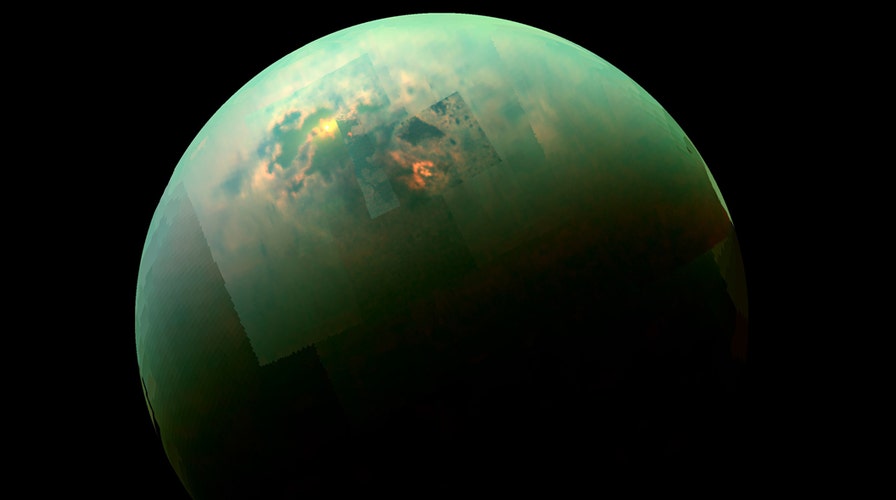Shortly before it plunged into Saturn's atmosphere in late 2017, NASA's Cassini spacecraft made an incredible observation about the ringed planet's moon, Titan – its lakes are extraordinarily deep and filled with methane.
Titan, Saturn's largest moon and the second-largest natural satellite in the Solar System behind Jupiter's moon Ganymede, has methane rain that can fill lakes as much as 330 feet deep, according to a new study published in the scientific journal Astronomy.
"Every time we make discoveries on Titan, Titan becomes more and more mysterious," said lead author Marco Mastrogiuseppe, Cassini radar scientist at Caltech in a statement. "But these new measurements help give an answer to a few key questions. We can actually now better understand the hydrology of Titan."
SCIENTISTS HAVE FOUND THE 'BUILDING BLOCKS' FOR LIFE ON SATURN'S MOON ENCELADUS
The researchers found that the hydrologic cycle on Titan is similar to that of Earth's, except that clouds and rain are not made up of water, but rather methane and ethane. Due to Titan's freezing cold temperatures, (it can reach as low as –290 degrees Fahrenheit), these hydrocarbons stay in liquid form, as opposed to gas, their state on Earth.

This near-infrared, color view from Cassini shows the sun glinting off of Titan's north polar seas. (Credit: NASA/JPL-Caltech/Univ. Arizona/Univ. Idaho)
The hydrology on the northern hemisphere of Titan is different than that on the other side, according to Cassini scientist and co-author Jonathan Lunine of Cornell University.
"It is as if you looked down on the Earth's North Pole and could see that North America had completely different geologic setting for bodies of liquid than Asia does," Lunine added in the statement.
A second paper published in Nature goes into greater depth on the hydrologic cycle of Titan, noting that there appear to be "seasonal surface changes" causing the change in the surface liquids.
After spending 13 years studying the planet, Cassini intentionally plunged into Saturn's atmosphere in September 2017.
ALIEN LIFE ON SATURN'S MOON? DUST STORMS ON TITAN SPOTTED FOR THE FIRST TIME
Methane-based life?
The prospect of methane-based life on Titan has been postulated before, after NASA found traces of vinyl cyanide in the atmosphere last year.
In January, researchers revealed that fresh rainfall had been spotted on Titan in 2016, which caused a reflective feature near the north pole of the moon.
In September 2018, dust storms were spotted on Titan for the first time ever, raising the prospect the storms could be a precursor to alien life on the celestial body.
It's possible the storms are comprised of "organic molecules" NASA said, due to the chemistry of the atmosphere. Titan's atmosphere is comprised of 98.4 percent nitrogen, 1.6 percent methane and 0.1-0.2 percent hydrogen.
SATURN'S BIGGEST MOON TITAN MAY BAKE ITS OWN ATMOSPHERE
However, once the organic molecules get big enough, they eventually fall to Titan's surface and may play a part in the dust storms.
The prevalence of dust storms and strong winds on Titan implies that the underlying sand can be moved as well and that the "giant dunes" that cover the moon's equatorial regions are constantly changing and still active.





















